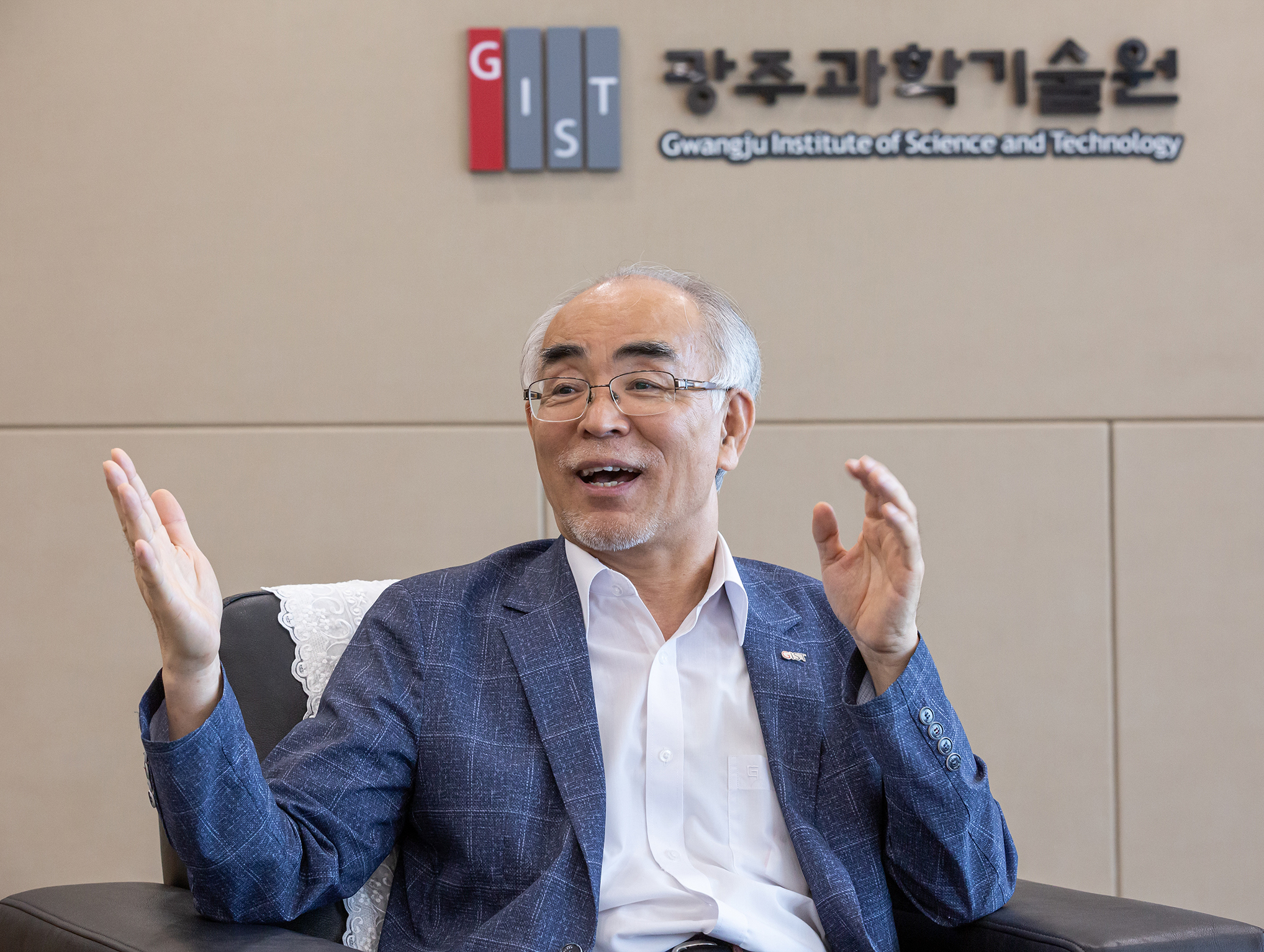This is GIST
Interview with President Kim Ki Seon.
Interviewed by Jeong Jiyeon and Melline Galani.
The Gwangju Institute of Science of Technology (GIST) not only has a proud history in Gwangju but also has an exceptionally beautiful campus, undoubtedly contributing to its present and future creativeness in science and technology. The Gwangju News is happy to present this interview with the president of GIST, Kim Ki Seon. — Ed.
Gwangju News (GN): Thank you for taking the time to do this interview for the Gwangju News, President Kim. First, please introduce yourself, and tell us about your background and about GIST. Also, how long have you been president of GIST?
Kim Ki Seon: Nice to meet you and welcome to the most beautiful park in Gwangju. I am Kim Ki Seon, president of GIST (Gwangju Institute of Science and Technology). Originally, I worked as an engineer, making 2G cell phones in Houston, U.S.A. However, 27 years ago, in 1994, when the high-tech district was established and GIST was also established, about ten professors from home and abroad came to Gwangju to nurture young students, and I was one of them.
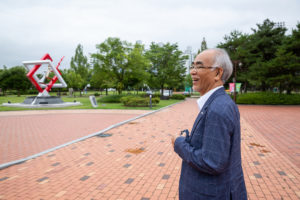
GIST was the second science and technology institute established in Korea after KAIST. GIST has tried everything new to fulfill its mission of establishing an innovative model for science and engineering institutions. As an innovative model, it started with a graduate school centered on master’s degree and doctorate programs, considering “convergence technology” and “globalization.” The official language on our campus is English, the global language of science and technology. All courses are taught in 100% English and have been successfully conducted so far. By creating this globalized environment, foreign students can adapt well to campus life without any difficulties. GIST has recently been selected as the world’s fourth-highest institution in the QS World University Evaluation for “citations per faculty” in pursuit of research cooperation and competition. As a result of this forward-looking effort, GIST’s Global Convergence Education model is being introduced as an innovative success story.
GN: How is the international community represented at GIST? What percentage of students at GIST are international students? What do international students bring to the GIST community?
Kim Ki Seon: Currently, foreign students and teachers account for about ten percent of GIST members. Starting in the fall of 2020, this rate will gradually increase as new undergraduate admissions and exchange student programs begin at our university.
Basically, the official language is English at GIST, which is oriented toward a global campus. All Koreans and foreigners receive full scholarships without discrimination, and all of them live in dormitories or apartments. Personal distress counseling and career counseling are conducted through the in-house support center, and the foreign assistance department and language center are also in charge of helping with campus life and daily life in Korea.
Recently, international students have participated as members of the general student council and the Self-Governing Committee of the Local Government to actively represent the foreigners’ positions and to resolve conflicts with Korean students. Through Open Tuesday, which is open to everyone and promotes free communication every Tuesday, various programs are set up and operated to improve the welfare of foreign members and resolve distress.
GN: What distinguishes a GIST education from other institutions of higher learning in Korea, and in particular, Gwangju? What specialized expertise can a potential student (foreign or domestic) expect to acquire at GIST that he or she could not obtain anywhere else?
Kim Ki Seon: GIST has the advantage of being a minority elite. When it was established, we benchmarked Caltech’s (California Institute of Technology) minority education in the United States – a world-class institution where the ratio of professors to students is one to ten. In addition, the selection of foreign undergraduate students at GIST for the first time this year is expected to make us a center for global education in both name and reality.
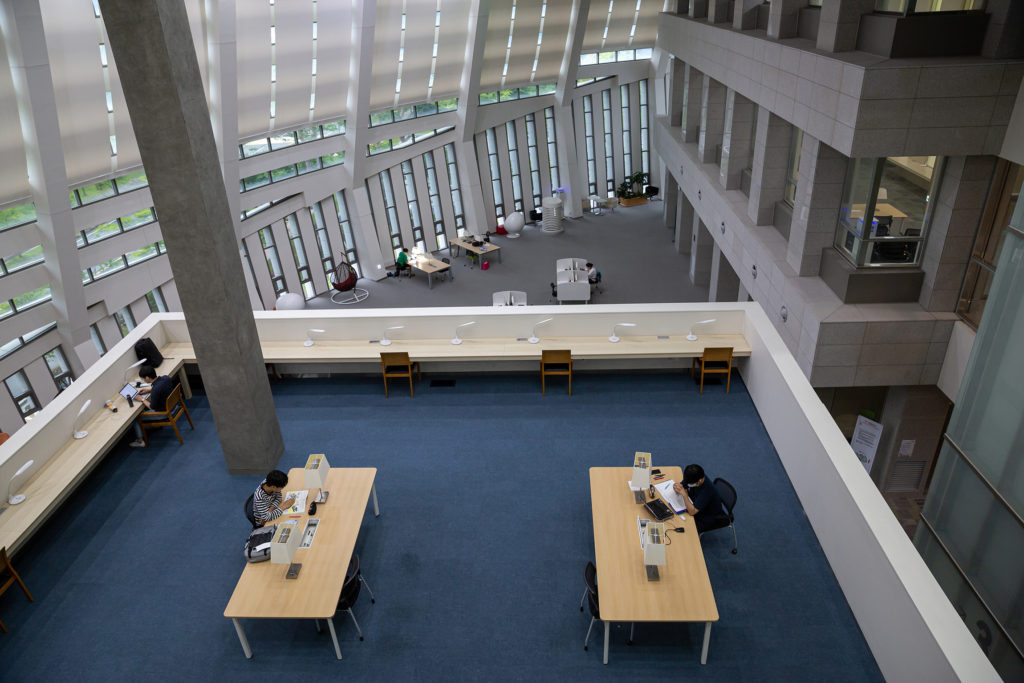
GIST is pursuing transformation into a liberal arts college and is pursuing this in a variety of ways. To cultivate basic literacy, all new students are admitted to the Faculty of Basic Education. Since the Institute of Science and Technology is an institution that fosters professional manpower in the fields of science and engineering, you may think that we would focus on science and engineering subjects, but GIST has designated courses in not only science and engineering but also in various liberal arts fields, such as the humanities, social sciences, language studies, and the arts. In their first year, students build their foundations in various fields, and after their second year, they can freely select majors in several relevant departments through freely declaring majors without competition with other students.
In particular, the “Infinite Challenge Project” is the most outstanding program compared with other universities. This project aims to cultivate active creative convergence talent by allowing students to experience failures through self-directed “individualized activities” and developing problem-solving skills through them. This project also deals with a variety of topics, from application creation and game development to movie production and theater, composition, and performance. Regardless of the field – humanities, society, culture, science, or academics – various activities are supported in amounts of up to 2.5 million won per team, and comparative activities are highly recommended.
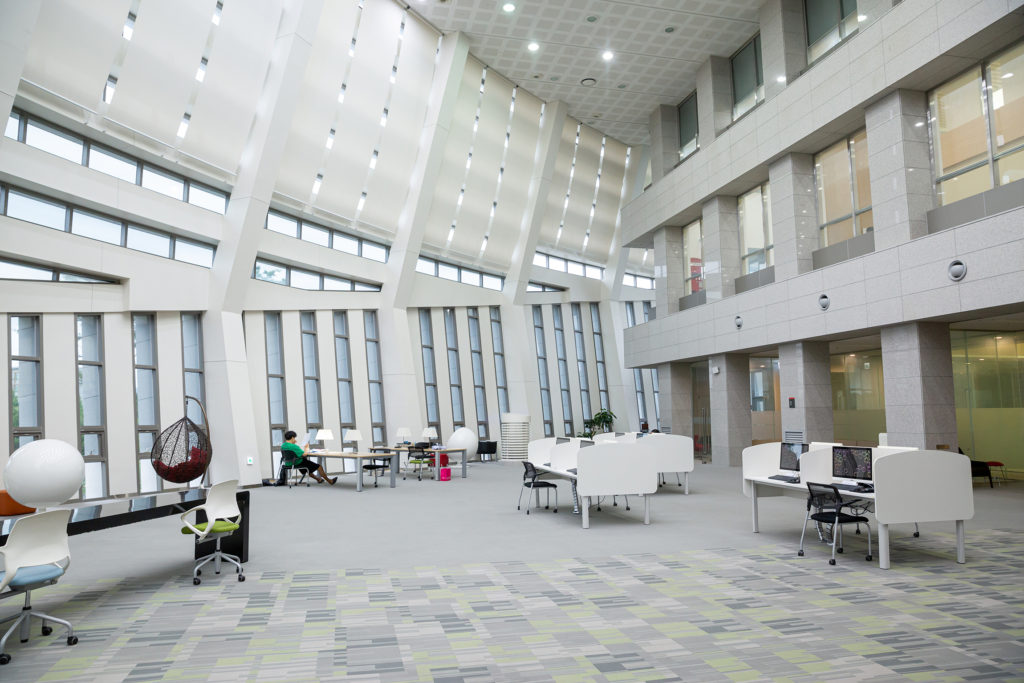
We are devoting support to infinite challenges to discover the potential in our students and to promote the cultivation of literacy as a convergent talent with respect, passion, and pride. In addition, to becoming a liberal arts college, GIST has been successfully conducting various educational experiments. GIST aims to efficiently manage undergraduate schools, with undergraduate students in their third and fourth years participating as researchers in graduate laboratories through active exchange between graduate schools and universities. The G-SURF program, which benchmarks Caltech’s SURF, is highly responsive to students because they can conduct actual research while receiving supervised mentoring at their desired graduate and university laboratories. There are also active exchanges with universities abroad. Second-year students who meet certain criteria can take summer semesters at UC Berkeley and Boston University in U.S., and at Cambridge University in the U.K.
GN: Especially for universities that deal with cutting-edge science and technology, corporate partnerships play an integral role. Would you speak about the importance of GIST’s corporate relations and how GIST develops relationships with industry?
Kim Ki Seon: GIST has been operating a CEO program called the GIST Technical Management Academy, or GTMBA for short, for the past ten years to promote partnerships with local companies and to provide a comprehensive CEO training program for entrepreneurs. About 400 alumni of GTMBA are actively engaged in various fields of business, politics, and communications, making great contributions to the community and continuing their exchanges with GIST. To maintain this exchange relationship, GIST provides various opportunities for communication with companies.
In addition, we hold a Breakfast Forum every month during the semester to promote R&D, technology transfer, and commercialization of technologies. Through the Breakfast Forum, we are trying to promote the establishment of a network between CEOs in Gwangju and Jeollanam-do and professors and researchers at GIST, and we are expanding opportunities to introduce GIST’s research technology for mutual benefit with small and medium-sized businesses. Although the Breakfast Forum has not been held this year due to COVID-19, we have been creating other opportunities where local CEOs can get some technical advice from GIST researchers, and the researchers can also get information on the development of technologies in local industries. Furthermore, we conduct various activities for mutual development, including having regular meetings with local entrepreneurs to discuss diverse ways to develop the industrial ecosystem in the local community.
GN: We heard that GIST’s excellent research results are recognized worldwide. Please tell us what the strategy is.
Kim Ki Seon: GIST has ranked first in Korea for 13 consecutive years and fourthin the world in the Citations per Faculty Index. In the QS World University Evaluation, citations per faculty is an important indicator of both the quantity and quality of research capabilities.
The driving force behind GIST’s growth into a global research-oriented university in a relatively short period of time is the result of attracting excellent researchers and creating an optimal research environment for them to concentrate on their research. GIST has been selected as the “best college for start-ups” for the past three years in a row. We help students identify their business potential and apply it to starting a business through the Start-up Idea Competition. GIST has been operating a professional training program focused on technology start-ups, and there is a start-ups minor in the master’s degree program that can lead students to actually creating their own start-ups. Another outstanding program that is a distinctive part of our curriculum sends students interested in starting a business to Israel’s Institute of Technology, Technion, to help them learn about start-ups at a global and practical level.
GIST has put its priority on global research under the GIST philosophy of emphasizing global convergence, and it has created a unique atmosphere in which to conduct joint research with global researchers who can be both competitors and partners, and this has naturally lead to our successful achievements in terms of the projects-per-professor index.

GN: In recent years, several high-profile industries have moved to Naju’s “Innovation City.” Has this affected the way GIST delivers its programs?
Kim Ki Seon: Innovation City was created in 2002–2003 during the Roh Moo-hyun administration when the Innovation City Act to distribute government agencies concentrated in the metropolitan areas to the provinces was revised. At that time, we were able to choose the areas of expertise we wanted to concentrate on by region, and Gwangju chose information and communication, energy, and agricultural. Since then, the Korea Internet and Security Agency for the information and communication sector, the Korea Contents Agency, and the Korea Electric Power Corporation for the energy sector have moved to Naju one after another. GIST will work with these institutions to create a blueprint of how to look forward to the next ten years to advance science and technology. Also, in the future, an AI cluster will be created in the high-tech district here, and I think it will be able to lead the economic revitalization of our region by attracting companies for research here in the Honam area.
GN: How does GIST maintain a positive relationship with the Gwangju community? Are there days when the community is welcome to visit the campus?
Kim Ki Seon: Gwangju to the World is a glocal campaign. I believe a good school is a school that is loved by the local community, and communication plays an important role here. Communication begins from within the school to the outside of it and to its community.
As suggested by our slogan, We Are GIST, “we” refers to all citizens of Gwangju, including GIST members. Unfortunately, due to the unexpected COVID-19 pandemic, this year we have not been able to hold any events in which Gwangju citizens are able to participate.
However, last year we held the first GIST Science and Culture Week. During the week, we revealed to Gwangju citizens a media facade made by the Institute of Culture and Technology and screened a robot movie called Big Hero on the wall of the GIST library.
In addition, we has tried to facilitate communications with the residents of Gwangju and lower their entry barriers to science by sharing aspects of various fields of science. Especially, we invited Professor Gérard Mourou, the winner of the 2018 Nobel Prize in Physics, to give a lecture to the public and hold the High-Technology Golden Bell Competition.
As we believe that science increases its value through communication with the public and that pride in scientists and engineers grows together with the public, we will invite parents of elementary, middle, and high school students to the GIST Promotion Event, once the COVID-19 situation ends.
GN: What plans is GIST making or considering to broaden its reach and expand its range of fields of study for the future?
Kim Ki Seon: GIST is focused on nurturing PhDs in science and engineering through post-doctoral training to foster future academic innovation. Based on its global research achievements and experience in conducting convergence education programs, GIST is planning to develop the Young Scientist Programs (YSP).
YSP will help young scientists to become PhD-level professionals whose role is essential in promoting science and engineering, and contributing to national development led by science and technology. GIST has become a success story in Gwangju, and now it plans to spread the GIST YSP model at home and abroad.
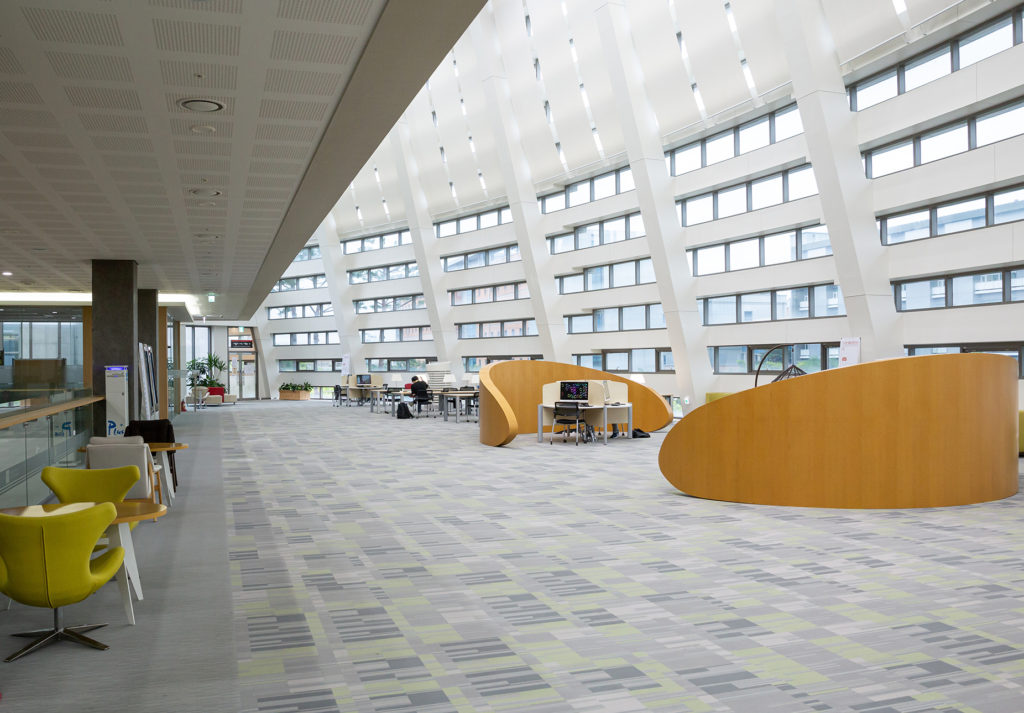
As a leading science institute for internationalization and convergence education models, GIST has already contributed to the enhancement of the quality of internationalized convergence education in many universities. Furthermore, with the support of the government, GIST is promoting the Global AI-X Education Innovation Model in cooperation with international research and innovation institutions as a part of the GIST YSP and expects to create successful innovation that can spread to many science and engineering universities.
Photographs by Kim Hillel Yunkyoung.







